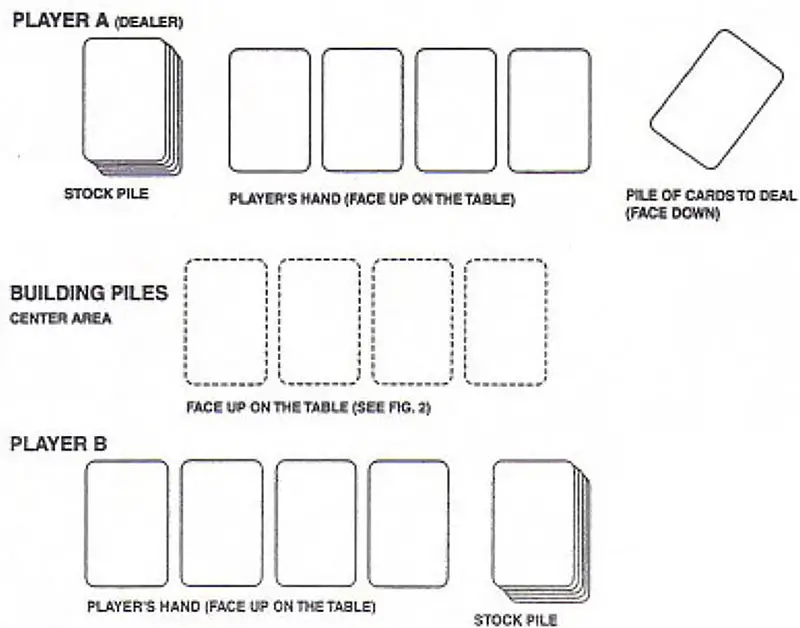
Components
- 80 cards (1 through 10)
- 16 Wild "Question Mark' Cards
- Instructions
Overview
Each player is dealt a "Stockpile" of 10 to 15 cards (depending on the number of players). The aim of the game is to get rid of these cards by creating Building Piles of cards in numerical sequence from 1 through 10.
A player is also dealt a Hand of 4 new cards face up at the beginning of his/her turn which are used to assist in playing the Stockpile.
Object of the Game
The first player to get rid of all the cards in his/her Stockpile wins.
Setup
-
Choose one player to be the Dealer.
-
The Dealer shuffles the cards. (If this is difficult for the Dealer, have a parent shuffle the cards, or lay them all face down on a flat surface and mix them up).
-
The Dealer then deals a Stockpile of cards face down to each player (refer to Figure 1 for where to place cards on the table). The number of cards dealt is determined by how many players are playing:
- If 2 players are playing, deal 15 cards to each player.
- If 3 players are playing, deal 12 cards to each player.
- If 4 or more players are playing, deal 10 cards to each player.
Turn over the top card from the Stockpile and place it face up on top. Hint: For a shorter game, deal fewer cards into each Stockpile.
-
The Dealer sets aside the remaining cards to be dealt out during play. Each turn begins with the Dealer dealing 4 cards face up to each player. This is the player's Hand.
-
The player to the left of the dealer starts.

Game Play
The object of the game is to get rid of all your cards in your Stockpile. You do this by playing cards in numerical sequence into Building Piles.
There can be a maximum of four Building Piles in the center of the play area. All players play cards on these four Building Piles. A Building Pile may only be started by playing a T card or a '?' Wild Card.
Each turn begins with the Dealer dealing 4 cards face up to each player.
During your turn, you may do these things:
If you have one or more "1 " or'?" Wild Card in your Hand or on top of your Stockpile, you may use them to start new Building Piles in the center of the play area (up to a total of four).
Once a Building Pile is started, you may play any cards from your Hand or top of the Stockpile that are next in numerical sequence. Continue playing until you can't play any more cards. It's now the next player's turn (the player to your left).
Note: Once you play a card on a Building Pile, you cannot take it back or move it to another pile.
Example of a Turn: Player #1 has four cards in her Hand: 9,1",?" (Wild Card) and 3. The card on top of her Stockpile is another"?" (Wild Card). Player #1 can use the 1 and both Wild Cards to start three new Building Piles (remember, there can only be four Building Piles total at any time).
Or Player #1 could start two Building Piles with the 1 card and a Wild Card, then play her second Wild Card on top of the 1 card (representing a 2 card), then play the 3 card on top of that Wild Card.
When Player #1 can't play any more cards, her turn ends. It's now the next player's turn (the player to her left).
At the beginning of each player's turn the player is dealt 4 new cards to his/her Hand. These are placed on top of any old cards left from the last turn. You can only play the top card of each pile this creates.
If you can play one of the new cards and then play the card that was underneath (an old card), you can do this as soon as it is revealed. Strategy Hint: If you can play a card from your Hand or from your Stockpile, play the card from your Stockpile. Then you'll be one card closer to winning!
When a Building Pile reaches "10", it is complete. Place the completed Building Pile to the side so another pile can be started in its place.
If the dealer runs out of cards, take all completed Building Piles and shuffle them together to create a new deck.
End of the Game
First player to play all the cards in his/her Stockpile first, wins! (You do not have to play all the cards in your Hand, only from your Stockpile).
Continue Reading


